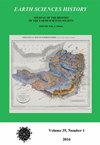THE SOCIETY, THE SAVANTS, AND THE SCIENTIST: A GLIMPSE AT THE SOCIÉTÉ GÉOLOGIQUE DE FRANCE THROUGH THE ACTIVITY OF THE FOUNDING MEMBER NÉRÉE BOUBÉE (1830-1860)
IF 0.6
4区 哲学
Q4 GEOSCIENCES, MULTIDISCIPLINARY
引用次数: 0
Abstract
The relevance of the Société Géologique de France (SGF) in the geoscientific landscape is undoubtedly recognized, but the academic literature dedicated to its history is scarce. The present paper aims to portray some aspects of the SGF's ordinary functioning filtered through the eyes and experience of a first-time member during the years he was active in the Society's life—approximately from 1830 to 1860. The basic assumption is that the SGF, similar to the Geological Society of London and other (geo)scientific societies, was an “arena of geological debate in the early Nineteenth century” (Rudwick 1986). Within this arena, not only scientific cultures, ideas, and practices were confronted, but also savants, experts, and amateurs clashed with each other. The constant and often very intense participation of Nérée Boubée (1806-1862) reveals much about the SGF and himself. We will follow his footsteps as a guiding thread of the narrative. Not being a savant, nor part of the élite of geology at his time, neither was Boubée a typical amateur. As was the case of many other members of the SGF, he may be considered an “accomplished” member— i.e., a geologist specialist in a more restricted subject (Rudwick 1985, p. 120). Boubée's trajectory within the SGF is a good window to see the functioning of the SGF in more detail, as it may also exemplify the paths followed by other ordinary members like him, who constituted the majority of the membership. The article concludes that the SGF was indeed an “arena” both in terms of the construction of knowledge and practices, and at the personal level of intra-community interactions.学会、专家和科学家:从创始成员 Nérée Boubée(1830-1860 年)的活动看法国地质学会
法国地质学会(SGF)在地球科学领域的重要性毋庸置疑,但专门研究其历史的学术文献却很少。本文旨在通过一位首次加入法国地质学会的会员的视角和经历,描述该学会在其活跃的年代(大约从 1830 年到 1860 年)的一些日常运作情况。基本假设是,SGF 与伦敦地质学会及其他(地质)科学学会类似,是 "十九世纪早期地质学辩论的舞台"(Rudwick 1986)。在这个竞技场上,不仅有科学文化、思想和实践的交锋,也有野蛮人、专家和业余爱好者之间的冲突。从布雷-布贝(1806-1862 年)持续且经常非常激烈的参与中,我们可以了解到有关 SGF 和他本人的许多信息。我们将追随他的足迹,将其作为叙事的线索。Boubée 既不是专家,也不是当时地质学界的精英,但他也不是一个典型的业余爱好者。与 SGF 的许多其他成员一样,他可以被视为一名 "有成就的 "成员,即在更有限的学科领域内的地质学家专家(Rudwick,1985 年,第 120 页)。布贝在 SGF 中的发展轨迹是一个很好的窗口,可以让我们更详细地了解 SGF 的运作情况,因为这也可以说明像他这样占成员大多数的其他普通成员所走过的道路。文章的结论是,无论是在知识和实践的构建方面,还是在社区内部互动的个人层面,SGF 确实是一个 "竞技场"。
本文章由计算机程序翻译,如有差异,请以英文原文为准。
求助全文
约1分钟内获得全文
求助全文
来源期刊

Earth Sciences History
GEOSCIENCES, MULTIDISCIPLINARY-HISTORY & PHILOSOPHY OF SCIENCE
CiteScore
1.00
自引率
0.00%
发文量
1
审稿时长
>12 weeks
期刊介绍:
Earth Sciences History promotes and publishes historical work on all areas of the earth sciences – including geology, geography, geophysics, oceanography, paleontology, meteorology, and climatology.
The journal honors and encourages a variety of approaches to historical study: biography, history of ideas, social history, and histories of institutions, organizations, and techniques.
Articles are peer reviewed.
 求助内容:
求助内容: 应助结果提醒方式:
应助结果提醒方式:


